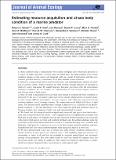Files in this item
Estimating resource acquisition and at-sea body condition of a marine predator
Item metadata
| dc.contributor.author | Schick, Robert Schilling | |
| dc.contributor.author | New, Leslie | |
| dc.contributor.author | Thomas, Len | |
| dc.contributor.author | Costa, Daniel | |
| dc.contributor.author | Hindell, Mark | |
| dc.contributor.author | McMahon, Clive | |
| dc.contributor.author | Robinson, Patrick | |
| dc.contributor.author | Simmons, Samantha | |
| dc.contributor.author | Thums, Michele | |
| dc.contributor.author | Harwood, John | |
| dc.contributor.author | Clark, James | |
| dc.date.accessioned | 2013-07-24T11:01:02Z | |
| dc.date.available | 2013-07-24T11:01:02Z | |
| dc.date.issued | 2013 | |
| dc.identifier | 50927985 | |
| dc.identifier | 0679ef69-a682-4f21-89d8-31faeb2df5f4 | |
| dc.identifier | 84886293977 | |
| dc.identifier.citation | Schick , R S , New , L , Thomas , L , Costa , D , Hindell , M , McMahon , C , Robinson , P , Simmons , S , Thums , M , Harwood , J & Clark , J 2013 , ' Estimating resource acquisition and at-sea body condition of a marine predator ' , Journal of Animal Ecology , vol. 82 , no. 6 , pp. 1300-1315 . https://doi.org/10.1111/1365-2656.12102 | en |
| dc.identifier.issn | 0021-8790 | |
| dc.identifier.other | ORCID: /0000-0002-7436-067X/work/29591690 | |
| dc.identifier.uri | https://hdl.handle.net/10023/3867 | |
| dc.description | This article was made open access through BIS OA funding. | en |
| dc.description.abstract | (1) Body condition plays a fundamental role in many ecological and evolutionary processes at a variety of scales and across a broad range of animal taxa. An understanding of how body condition changes at fine spatial and temporal scales as a result of interaction with the environment provides necessary information about how animals acquire resources. (2) However, comparatively little is known about intra- and interindividual variation of condition in marine systems. Where condition has been studied, changes typically are recorded at relatively coarse time-scales. By quantifying how fine-scale interaction with the environment influences condition, we can broaden our understanding of how animals acquire resources and allocate them to body stores. (3) Here we used a hierarchical Bayesian state-space model to estimate the body condition as measured by the size of an animal's lipid store in two closely related species of marine predator that occupy different hemispheres: northern elephant seals (Mirounga angustirostris) and southern elephant seals (Mirounga leonina). The observation model linked drift dives to lipid stores. The process model quantified daily changes in lipid stores as a function of the physiological condition of the seal (lipid:lean tissue ratio, departure lipid and departure mass), its foraging location, two measures of behaviour and environmental covariates. (4) We found that physiological condition significantly impacted lipid gain at two time-scales – daily and at departure from the colony – that foraging location was significantly associated with lipid gain in both species of elephant seals and that long-term behavioural phase was associated with positive lipid gain in northern and southern elephant seals. In northern elephant seals, the occurrence of short-term behavioural states assumed to represent foraging were correlated with lipid gain. Lipid gain was a function of covariates in both species. Southern elephant seals performed fewer drift dives than northern elephant seals and gained lipids at a lower rate. (5) We have demonstrated a new way to obtain time series of body condition estimates for a marine predator at fine spatial and temporal scales. This modelling approach accounts for uncertainty at many levels and has the potential to integrate physiological and movement ecology of top predators. The observation model we used was specific to elephant seals, but the process model can readily be applied to other species, providing an opportunity to understand how animals respond to their environment at a fine spatial scale. | |
| dc.format.extent | 16 | |
| dc.format.extent | 2044012 | |
| dc.language.iso | eng | |
| dc.relation.ispartof | Journal of Animal Ecology | en |
| dc.subject | Resource acquisition | en |
| dc.subject | Bayesian | en |
| dc.subject | Elephant seals | en |
| dc.subject | Markov chain Monte Carlo | en |
| dc.subject | Satellite telemetry | en |
| dc.subject | State-space model | en |
| dc.subject | Body condition | en |
| dc.subject | Año Nuevo | en |
| dc.subject | Macquarie Island | en |
| dc.subject | Q Science | en |
| dc.subject | SDG 14 - Life Below Water | en |
| dc.subject.lcc | Q | en |
| dc.title | Estimating resource acquisition and at-sea body condition of a marine predator | en |
| dc.type | Journal article | en |
| dc.contributor.sponsor | Office of Naval Research | en |
| dc.contributor.institution | University of St Andrews. School of Mathematics and Statistics | en |
| dc.contributor.institution | University of St Andrews. Statistics | en |
| dc.contributor.institution | University of St Andrews. Marine Alliance for Science & Technology Scotland | en |
| dc.contributor.institution | University of St Andrews. Centre for Research into Ecological & Environmental Modelling | en |
| dc.contributor.institution | University of St Andrews. School of Biology | en |
| dc.contributor.institution | University of St Andrews. Scottish Oceans Institute | en |
| dc.contributor.institution | University of St Andrews. St Andrews Sustainability Institute | en |
| dc.identifier.doi | 10.1111/1365-2656.12102 | |
| dc.description.status | Peer reviewed | en |
| dc.identifier.grantnumber | N00014-12-1-0286 | en |
This item appears in the following Collection(s)
Items in the St Andrews Research Repository are protected by copyright, with all rights reserved, unless otherwise indicated.

